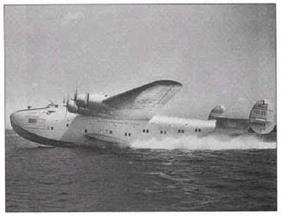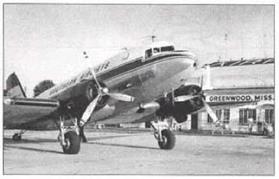The Airlines Reap the Benefits
From Lindbergh’s flight in 1927 through the 1930s, when Earhart set record after record amid thick newspaper, radio, and newsreel coverage, the American public grew fond of the idea of traveling adventurously by airline. Airlines began to spring up and prosper, thanks in part to companies that operated cheaply and efficiently, but also because of the passenger-pampering luxury some of them offered.
As manufacturers like Boeing and Ford began to sense the birth of a new industry, airplanes metamorphosed into lumbering, ear-splitting luxury suites with wings. Food rivaling that offered in the finest restaurants was served to nattily dressed travelers who reclined in thick-cushioned comfort. They departed from exotic locations in the
South Pacific and the Spanish Main of South America in flying ships that bore names like The Bermuda Clipper and the Clipper Evening Star. Passengers sipped wine or, in the case of Western Airlines, champagne, while attractive stewardesses prepared cozy sleeping compartments for the fatiguing flights. Modern jet travel, even in the firstclass compartment, can’t hold a candle to the luxury offered in the golden age of the airlines.
|
The Boeing 314 helped Pan American Airways launch its legendary Clipper Service. Here, the Dixie Clipper rides heavily and steadily through the water. |
One of the favorites of passengers, pilots, and airline executives alike was the Douglas DC-3, which made its inaugural flight in 1935. Before then, flying long distances was an experience that tested the mettle—and the patience—of even the most hardy traveler.
Passengers loved the DC-3’s roominess and speed, which for the first time made flying comfortable. Pilots found the plane stable and easy to fly, or as pilots say, “honest.” Most importantly for the growing industry, airline executives appreciated the DC-3’s reliability and low operating cost. DC-3s were strong and reliable, meaning they cost less to repair. And their low cost meant that tickets were affordable, attracting more passengers. To this day, the 65-year-old “Grande Dame of the Skies” is working just as hard as she did in her heyday.
As airlines began to really rake in the profits, Boeing was the one that became most synonymous with air travel. Though Boeing didn’t build the first commercial jet, its four-engine 707 is remembered as the airliner that connected America’s east and west coasts, and helped coin the word “nonstop.” For the first time, passengers could, without fear, board a plane in New York and step off in San Francisco or London a few hours later.
|
If there was one airplane that can claim credit for winning the devotion of the flying public, it was the DC-3, which served as everything from a war bird to charter plane. The “Grand Old Gal” is still in service today. |
|
Plane Talk The DC-3 has been part of юте of history’s most massive undertaking*, including "flying the hump" over the Himalayas mountain range from India to China, carrying provisions to evade a Japanese blockade. Later, in 1?4$, the DC-3 blockade runner went to work again, supplying West Berlin with food and provisions for an entire year. To this day, the very sight of a DC-3 can bring a grateful tear to the eye of many a Berliner. |
Such aviation feats would have been hard to imagine without Charles Lindbergh and Amelia Earhart. Though they never worked together, their influence on the American public was as strong as if they had coordinated their promotion of aviation.
Because the flying exploits of Lindbergh and Earhart took them around the world, American travelers for the first time began to think of the distant continents as places that could be reached by air, and not only by the slow-moving ocean vessels.
And thanks to radio, their flights, and particularly Earhart’s, were adventures that Americans could follow in their living rooms. For the first time, water-cooler talk in steno pools and factory floors around the country centered on American aviators breaking flying records in faraway places.
|
Plane Talk The genius and influence of Charles Lindbergh remains with us even today. When we board a Boeing 747, we are getting into an airplane that Lindbergh helped conceive in the late 1950s. He wanted to create the finest airliner of all time, and the massive 747 has lived up to that high standard. It’s fitting that it was designed in part by one of the greatest voices for the airline industry. |
The Least You Need to Know
> Charles Lindbergh worked hard to learn to fly and applied his skill to winning the lucrative Orteig prize.
>- Amelia Earhart was a better women’s advocate than pilot, and her disappearance might well have resulted from poor flying judgment
>- The Douglas DC-3 ushered in the airline industry.
>* The airlines owed much of their success to the exploits of Lindbergh and Earhart, who fired the imaginations of a nation erf would-be adventurers.















